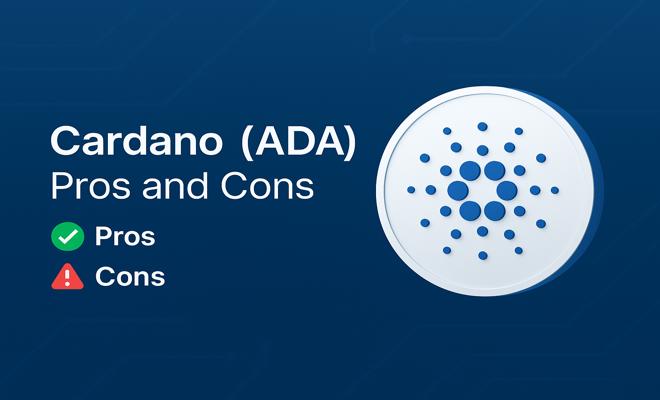
Cardano: A Comprehensive Review
Cardano (ADA) stands as one of the most innovative and scientifically grounded blockchain projects in the rapidly evolving cryptocurrency ecosystem. Founded by Charles Hoskinson, one of Ethereum’s co-founders, Cardano was designed to address the key limitations of earlier blockchains such as limited scalability, excessive energy consumption, and sustainability challenges.
With a unique approach that emphasizes peer-reviewed academic research and formal methods, Cardano aims to create a robust and secure decentralized platform. But does this meticulous methodology position Cardano as a leading blockchain contender? Let’s dive deeper into what makes Cardano stand out and where it still faces hurdles.
✅ Cardano’s Key Strengths
🧠 1. Research-Based and Scientific Development
What truly differentiates Cardano from many other blockchain projects is its commitment to a scientific, research-first philosophy. Every major protocol and upgrade undergoes rigorous peer review by academics and cryptographers worldwide before implementation. This ensures a high degree of security and reliability, reducing risks of critical bugs and vulnerabilities.
Cardano’s emphasis on formal verification techniques — mathematical proofs that validate the correctness of code — bolsters its reputation as one of the most secure blockchains to date.
🧱 2. Innovative Two-Layer Blockchain Architecture
Cardano employs a novel dual-layer design that separates its blockchain into two distinct but interoperable layers:
- Cardano Settlement Layer (CSL): This layer handles the ADA cryptocurrency transactions, providing a secure and efficient transfer of value.
- Cardano Computation Layer (CCL): Dedicated to smart contracts and decentralized applications (dApps), this layer allows flexibility and upgrades without disrupting the settlement process.
This separation improves scalability, maintainability, and security by isolating transaction handling from smart contract execution.
🔋 3. Environmentally Friendly Proof-of-Stake Consensus: Ouroboros
Unlike energy-intensive Proof-of-Work (PoW) blockchains like Bitcoin, Cardano uses Ouroboros, a highly efficient Proof-of-Stake (PoS) protocol. Ouroboros dramatically reduces energy consumption by selecting validators based on the amount of ADA they hold and stake, rather than computational power.
This approach not only minimizes the environmental footprint but also lowers operational costs, making the network sustainable and attractive for long-term adoption.
⚠️ Cardano’s Challenges and Weaknesses
🐢 1. Slow and Deliberate Development Process
Cardano’s rigorous development approach, while ensuring high-quality output, also results in a slower rollout of features. This measured pace sometimes frustrates developers and users eager for rapid innovation, especially in a competitive space where platforms like Ethereum and Solana regularly push updates and new functionalities faster.
Consequently, some dApp developers choose alternative blockchains that offer more mature tools and faster deployment timelines.
📉 2. Limited Adoption and Ecosystem Growth
Despite impressive technology, Cardano has struggled with achieving mass adoption. After the Alonzo upgrade introduced smart contract capabilities, expectations for a surge in decentralized applications were high. However, dApp growth and developer interest have remained moderate compared to Ethereum’s expansive ecosystem.
This slower ecosystem expansion presents a challenge in attracting new users, partnerships, and real-world use cases.
🚀 What Lies Ahead for Cardano?
Cardano’s team remains committed to ongoing improvements and ambitious projects aimed at scaling and adoption:
- Hydra: An advanced Layer 2 scaling solution designed to increase transaction throughput to potentially millions per second, drastically improving network capacity and speed.
- Global Partnerships: Cardano is actively forging collaborations with governments, educational institutions, and non-profits — especially in Africa — to enable blockchain-based solutions for finance, identity, and agriculture.
- Continuous Research & Upgrades: The development team continues to publish academic research and upgrade protocols, striving to enhance scalability, interoperability, and usability.
If these initiatives achieve their goals, Cardano could strengthen its position as a leading smart contract platform. However, success depends on real-world adoption, developer ecosystem growth, and how it stacks up against fast-moving competitors.
🧾 Conclusion
Cardano represents a pioneering blockchain project that blends rigorous academic research with innovative technology. Its scientific development process, dual-layer architecture, and eco-friendly Proof-of-Stake consensus make it uniquely positioned for secure and sustainable growth.
Nonetheless, the project’s slow development cycle and relatively limited adoption remain significant hurdles. For investors and developers willing to take a long-term view, Cardano offers high potential — but patience and careful observation are crucial.
Disclaimer: As with all cryptocurrency investments, it’s vital to conduct your own thorough research and consider risks before making any decisions.
Comments for this post
Comment body :
Hi Good content Thanks